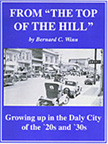
|
INCLINE PRESS 2 Townsend St., 2-213 San Francisco, CA 94107 (415) 284-0127 |
|||||||||||||||||
|
|
|||||||||||||||||
|
|
|||||||||||||||||
|
|||||||||||||||||
|
SAN FRANCISCO PHOTOS |
|||||||||||||||||
|
|
|||||||||||||||||
|
|
|||||||||||||||||
|
|||||||||||||||||
|
|
|||||||||||||||||
|
|||||||||||||||||
|
|
|||||||||||||||||
|
|||||||||||||||||
|
|
|||||||||||||||||
|
|||||||||||||||||
|
|
|||||||||||||||||
|
|||||||||||||||||
|
|
|||||||||||||||||
|
|||||||||||||||||
|
|
|||||||||||||||||
|
|||||||||||||||||
|
|
|||||||||||||||||
|
|||||||||||||||||
|
|
|||||||||||||||||
|
|||||||||||||||||
|
|
|||||||||||||||||
|
|||||||||||||||||
|
BOOKS |
|||||||||||||||||
|
|
|||||||||||||||||
|
|
|||||||||||||||||
|
|||||||||||||||||
|
|
|||||||||||||||||
|
|||||||||||||||||
|
|
|||||||||||||||||
|
|||||||||||||||||
|
|
|||||||||||||||||
|
|||||||||||||||||
|
|
|||||||||||||||||
|
|||||||||||||||||
|
|
|||||||||||||||||
|
|||||||||||||||||
|
|
|||||||||||||||||
|
|||||||||||||||||
|
|
|||||||||||||||||
|
|||||||||||||||||
|
|
|||||||||||||||||
|
|||||||||||||||||
|
|
|||||||||||||||||
|
|||||||||||||||||
|
|
|||||||||||||||||
|
|||||||||||||||||
|
|
|||||||||||||||||
|
|||||||||||||||||
|
|
|||||||||||||||||
|
|||||||||||||||||
|
NON-SAN FRANCISCO PHOTOS |
|||||||||||||||||
|
|
|||||||||||||||||
|
|
|||||||||||||||||
|
|||||||||||||||||
|
|
|||||||||||||||||
|
|||||||||||||||||
|
|
|||||||||||||||||
|
|||||||||||||||||
|
|
|||||||||||||||||
|
|||||||||||||||||
|
|
|||||||||||||||||
|
|||||||||||||||||
|
OTHER STUFF |
|||||||||||||||||
|
|
|||||||||||||||||
|
|
|||||||||||||||||
|
|||||||||||||||||
|
||||
|
|
||||
|
|
SACRAMENTO, WILLIAMS, ORLAND, CORNING. 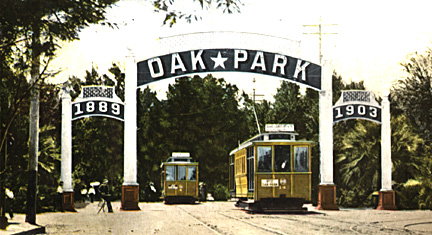 The above arch was built in c1903 and was located in the community of Oak Park in Sacramento. The name OAK PARK in the center section of the arch was fitted with electric light bulbs to illuminate it at night. If the construction date is correct, the arch would be the earliest known in the state. The date of its removal and exactly where Oak Park was located in Sacramento is not clear. Sacramento Library photo.  The Williams arch was dedicated in 1917 when most travelers arrived in Williams via the railroad. The city, wanting it to be easily seen by train passengers, positioned the arch across "E" Street in plain view of the Southern Pacific station. After 68 years of abuse by the weather and errant autos and trucks, the arch was taken down in 1985 for restoration. Most of the population of this farming community were 100% behind the restoration and could hardly wait for its return to its original locaton: "So" as the city council said, "It could continue to do what arches are suppose to do — welcome visitors and remind townspeople that Williams is a good place to live." Willows is located about 60 miles north of Sacramento and the arch looks as good or better today than it did 85 years ago. Photo by Albert Pulley Jr., Yuba City. 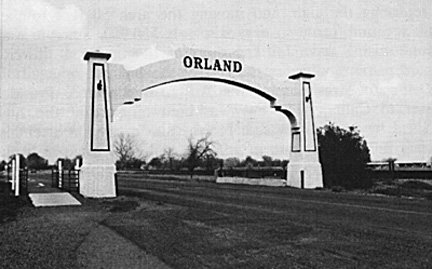 Life was not easy for the proponents of the Orland Welcome Arch. In 1926, for example: The Orland Unit, Orland's local newspaper, wrote,"...The municipal band is to be given a more or less honored burial, and the highway arch will be its tombstone...." With friends like that, the arch needed all the help it could get. By July of 1926, however, the arch, which was built in Sacramento and trucked to the site, was installed over Highway 99. The generous clearances the arch affords explains how it has managed to stay put over a state highway so long. When the structure was new, the light fixtures on the face of pillars were fitted with round globes, but they proved to be too tempting a target for rocks and other missles, so the practiice was discontinued. Photo by Ed Barkland, Orland. 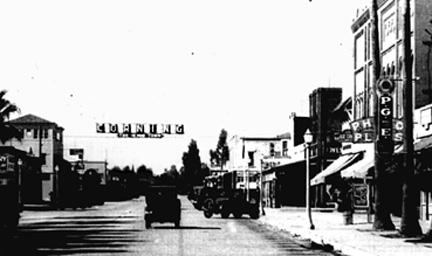 In 1891, the City of Corning, formerly Riceville, was founded by the Maywood Colony, a major land developer. When the area was suffering from a depression arounnd 1905 and 1906, it appeared in danger of becoming what was known as a "saloon" town. Because of the Maywood Colony's advertisements in religious periodicals, many people opposed to saloons had been attracted to the town and were angry at what they saw happening. Seeking to take control by incorporating it into a city, they won an election in September of 1906 that did just that and more. They also voted to adopt prohibition. To celebrate their dual victory, the city fathers erected the Corning Welcome Arch/Sign across Solano Street at Fourth the following year. The sign spelled out the slogan, CORNING The Clean Town, in electric lights. The slogan had nothing to do with brooms or dirty streets, but everything to do with cleaning the saloons out of the town. By 1924, however, the whole country was "dry" and the people of Corning had come to think of the slogan as meaning clean streets, parks etc. After years of trying to justify to critics why Corning rated the title, "The Clean Town," they decided to change the slogan to CORNING The Olive Town, a title they felt would go unchallenged. In February of 1924, the sign was taken down and the wording on it changed. Supported by cables, the sign hung across Solano Street until c1933. Dorothy E. Harper photo. 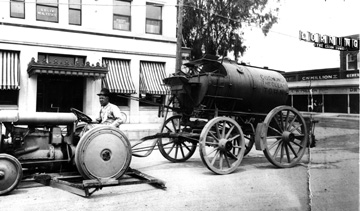 The original sign with the slogan "The Clean Town." Photo by Dorothy E. Harper, Corning. If you know of any Welcome Arches in California, past or present, that are not shown here, I would like to hear from you. In my book, Arch Rivals, I have many more and some will be added to this site, but I am always looking for any that I may have missed. Click here to Email us  Welcome Arches #5 |
|
||